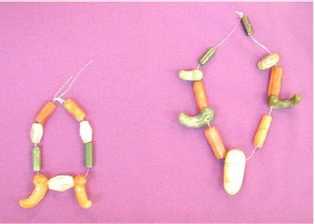勾玉(まがたま) - Magatama
Beads have been an important part of human decoration for centuries. Tama (balls) have had a special meaning for people in the far east for just as long. There are four aspects to the ancient meaning of the ball. The four are: Ninigimitama (harmony), Aramitama (bravery), Sakimitama (graciousness), and Kushimitama (working wonders). Everyone will agree these characteristics are very important to human beings. However the most important ball in Japan is the Magatama, which is known as the Curved Jewel.
数珠玉は、人類の装飾品の歴史の中で重要な位置を占めています。玉は極東に住む人々にとって、特別な意味を持っていました。 古代、玉には、ににぎみたま(調和)、あらみたま(勇敢)、さきみたま(優雅)、くしみたま(奇跡)と四つの意味が込められていました。現在でもこうした資質が人間の理想であることは衆目の一致するところでしょう。しかし、日本において最も重要な意味を持っていたのは、曲がった玉「勾玉」でした。
The history of Magatama goes back to the middle of the Jomon era, around 3500 B.C. The curved shape was standardized in the Yayoi Era (300 B.C. – 300 A.D.) and the Kofun Era (300 A.D. – 710 A.D.). This was a period of about 1000 years, which ended 1300 years ago, or so. Green jade was the most important material as a status symbol, probably because it is so hard to work with. Magatama are made of many materials. Strangely enough, some of these materials are not found in Japan, but in China and Korea instead. Does this mean that Magatama, the Curved Jewel, originated there? I don’t think so.
勾玉の歴史は紀元前3500年ごろの縄文時代中期に始まり、弥生時代(紀元前300〜西暦300)から古墳時代(西暦300〜710)の約1000年の時をかけて、ほぼ現在のような形に固まりました。今から約1300年前のことです。勾玉の製作にはさまざまな石が用いられましたが、翡翠はたいへん硬く加工するのが困難であったため、これを元に作られた勾玉はある種のステータスシンボルでした。そして、奇妙なことに、日本には存在しない中国や朝鮮半島産の石で作られたものもあります。これは、そうした地域に勾玉の起源があるということを意味しているのでしょうか。私は決してそうは思いません。
Magatama, the Curved Jewel of Japan, is most significant to this country because in the sixth century, a set of curved jewels became a part of the Three Imperial Regalia! The first of the three Imperial Regalia is a mirror, and the third is a sword. All these treasures were received by Ninigi no Mikoto from Amaterasu, the Sun Goddess, when he first came to Japan. The three have been thought to represent the Sun, the Moon, and lightning, respectively.
勾玉はその首飾りが鏡、剣と並んで6世紀に誕生した三種の神器の一つであることからもわかるように、この国の宝のはずです。神器の最初は「鏡」、最後は「剣」です。三つの品はニニギノミコトが日本に降臨したとき、太陽の女神天照大神から授かったもので、鏡は太陽を、勾玉は月を、剣は光をそれぞれ象徴するといわれます。
In streams in the early Jomon era, people found pebbles with tiny holes in them. The holes had been naturally formed by the action of the water. Water is powerful! Go to the Oni-no-Shita-Burui Gorge some day and see what I mean. Though these Jomon Era pebbles were smooth, they were almost all uneven in shape. The people found them beautiful and made from them the really ancient necklaces we sometimes find in burial sites of that period. Later on, people learned to make the pebbles into a standard Magatama (curved jewel) shape, and assigned them religious significance. Early jewels were handmade by rubbing the material on other stones to establish the shape and then polishing the rough bead on wooden blocks until both ends were exactly alike. In tracing the history of the Curved Jewel, I visited the Shiryo-kan (Exhibition hall) in Tamatsukuri. At that time it was managed by Mr. Mamoru Katsube. He very kindly explained the tools and the process involved in making the Curved Jewels. Tamatsukuri is famous as the place the Curved Jewels are made.
縄文時代初期、人々は水の流れによって穴が開いた小石を川の中に見つけました。水の力は私たちの想像を超えています。鬼の舌震に行けば、同じものを目にすることができます。表面は同じように滑らかでも形はそれぞれ異なる小石に、縄文人は魅了されたことでしょう。そしてそれを材料に彼らは首飾りを作りました。それらは現在でも当時の埋葬地から発掘されることがあります。やがて、縄文人は小石から勾玉を作る技術を生み出し、それに宗教的な意味を与えるようになります。初期の勾玉は人間の手作りで、小石を別の石で削って大まかな形を作り、それを木片で磨いて両端の形を均等にしていくという手法を用いました。勾玉の歴史をたどるため、私は以前その生産地として名高い玉造の資料館を訪ねたことがあります。当時の館長、勝部衛さんが勾玉製作の工程、使用された道具についてていねいに説明してくださいました。
After the fifth century, crystal and amber became popular for the jewels, but in Tamatsukuri, green agate, the most cherished material, is found. At a certain stage in Japan’s history, class systems of workers were established. One of these systems was called the Be system. The people of the Be system made articles for the royal family and other rich and powerful families of the period. In Tamatsukuri, the Imbe family controlled this geographical center of Curved Jewel production. As I have mentioned before, I doubt the correctness of the modern day interpretations of the meaning of the Curved Jewel’s shape. Some say the shape was intended to represent the moon, but there is only one moon, and Magatama were used in strings.
5世紀以降、水晶や琥珀で作られた勾玉が主流になっていきましたが、玉造では緑色のめのうが最も重宝されています。日本の歴史の一時期、労働者は職能集団に分けられていました。その中の一つに、皇室や当時の豪族を始めとする特権、富裕階級に属する人々に献上する品物を作ることを任務とした「部」がありました。玉造では「忌部」が勾玉の生産を統括していました。以前にも述べましたが、勾玉の形状の意味をめぐる議論に対して、私はどうも懐疑的にならざるをえません。勾玉は月にならったものだとする意見がありますが、勾玉は数個を紐に通して首飾りとして用いたのに対し、月は一つしか存在せず整合性に欠けます。
Others insist the shape is a copy of tiger claws, holy in China. If that were true, there would be many strings of tiger claws, but there aren’t. Others suggest the Curved Jewel took its shape from a Korean Bronze Age ornament. It this were true, wouldn’t we have ancient examples and/or drawings, as we do for so many other ancient decorations? I don’t like this explanation either. I continue to think the Magatama was made in a curved shape to represent the new fetus. The shape is the same and the hole corresponds with the placement of the eyes of a fetus. The fact that many Magatama were necessary to make a set, seems to me to correspond with the wish for an abundance of offspring.
中国では神聖なものとされる虎の爪を真似たものではないかという説もあります。しかし、もしそれが本当なら多くの虎の爪を紐に通したものが発見されなくてはなりませんが、もちろんそんなものは見つかっていません。さらに、朝鮮半島の青銅器時代に作られた装飾品からヒントを得て作られたものだと主張する人もいます。が、勾玉に類するほかの物や絵など、ほかの古代の装飾品にはよく見られるものがないことから、この説も信憑性に欠けます。
I think the ancient religious significance of the Curved Jewel was that of a fertility symbol! That idea fits in with the thinking of the people of those days – being prolific!
私の意見では、勾玉は胎児を表しているのではないかと思います。形はとてもよく似ていますし、穴は胎児の目の位置と同じ場所にあります。勾玉は、通常複数のものが固まって発見されることが多く、このことも子孫繁栄を願う人々の祈りを象徴しているように思えてなりません。宗教的装身具としての勾玉は多産の象徴だったに違いありません。このことは当時の人々の価値観、“多産は良いこと”とも一致しています。
